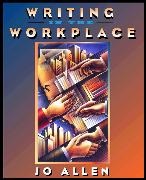Share
Fr. 144.10
Jo Allen
Writing in the Workplace
English · Paperback / Softback
Shipping usually within 3 to 5 weeks
Description
List of contents
All chapters include “Summary,” “Checklist,” and “Exercises.”
1. Understanding the World of Workplace Writing: Organizational Images, Cultures, And You.
Your Experience as a Writer.
Your Role as a Workplace Writer.
Organizational Image.
Organizational Culture.
Changes in Organizational Culture.
Organizational Image, Culture, and Communication.
Ethics and Communication.
Changes in Workplace Communication.
2. Planning Your Writing Strategy.
Getting On-The-Job Writing Projects.
Planning the Strategy: An Overview of the Writing Situation.
Matching Audience and Purpose.
Negotiating the Content/Context.
Assuming the Writer's Role.
Putting the Strategy to Work.
Scheduling the Writing Project.
3. Researching and Gathering Information: Preliminaries, Sources, and Strategies.
Preliminaries in Gathering Information.
Sources for Gathering Information.
Strategies for Gathering Information.
The Ethics and Elements of High Quality Research.
4. Constructing and Organizing Information for Your Reader.
The Rationale for Organizing Workplace Documents.
Strategies for Organizing Workplace Documents.
5. Drafting Your Workplace Documents.
Experimenting with Prewriting Strategies.
Putting Prewriting Strategies to Work.
Drafting the Introduction for Workplace Documents.
Drafting the Discussion for Workplace Documents.
Drafting the Conclusion for Workplace Documents.
Drafting the Appendixes for Workplace Documents.
6. Revising Your Workplace Documents.
Prioritizing Your Revisions.
Accommodating Initial Revisions: The Big Picture.
Revising for Appropriate Information.
Revising for a Clear Sense of Audience, Purpose, and Organization.
Revising for an Appropriate Language and Style.
Proofreading the Final Document.
7. Collaborating in Workplace Writing.
The Competitive versus the Collaborative Workplace Model.
Advantages of the Collaborative Workplace Model.
Variations on the Collaborative Model.
Featured Roles in Collaborative Groups.
Document Issues.
Process Issues.
Relationship Issues.
Personality Roles in a Collaborative Group.
Conflict in Collaborative Relationships.
8. Using Graphic Elements in Workplace Documents.
Accommodating Audience Needs.
Incorporating Graphics into Your Text.
Acknowledging the Source of Your Graphics.
Illustrating Comparisons and Relationships for Quantitative Data.
Illustrating Physical Features.
Using Graphics Professionally: Additional Do's and Don'ts.
Controlling the Rhetorical Message of Graphics.
9.Designing and Formatting Your Workplace Document.
Design for Informative and Persuasive Documents.
Audience Factors in Design and Format.
Design Elements.
Format Elements.
Applications and Document Factors.
10. Letters and Memos.
The Technology of Letters and Memos.
Messages of Letters and Memos.
Hard Copy or On-Line: How to Choose the Medium.
Organization of Correspondence.
Additional Persuasive Touches: Humor, Personal Messages, and Response Generators.
Standard Features of and Formats for Letters and Memos.
11. Employment Communications: The Résumé and Letter of Application.
Audience and the Employment Communication Package.
Drafting the Résumé: A Worksheet Approach.
Choosing a Format for Your Résumé.
Refining Your Résumé's Content.
Drafting the Letter of Application: A Worksheet Approach.
Refining the Letter of Application.
12. Informational Reports and Instructions.
The Audience for Informational Reports.
The Purpose of Informational Reports.
Topics for Informational Reports.
Definitions of Terminology in Informational Reports.
Types of Informational Reports.
Instructional Writing.
13. Analytical Reports.
Audiences for Analytical Reports.
Purposes and Topics of Analytical Reports.
Types of Analytical Reports.
14. Proposals.
An Overview of the Proposal Process.
The Writer's Role in the Proposal Process.
Readers of Proposals.
Types of Proposals.
The Proposal Writing Process.
Criteria for Evaluating Proposals.
15. Elements and Options for Short/Informal and Long/Formal Reports.
The Length Issue: Short and Long Reports.
Short/Informal Report Format Options.
Long/Formal Report Format Requirements.
16. Oral Communications in the Workplace.
Differentiating Between Types and Purposes of Presentations.
Preparing for the Presentation.
Adding Visual Interest to Your Presentation.
Delivering the Presentation.
Handling Question-and-Answer Sessions.
Summary
Writing at work is made easier with this all-inclusive guide. Offering a practical approach to writing in print and electronic formats, these pages explore organizational images and cultures, a writing strategy; researching; revising; incorporating graphics; letters and memos; design; employment communication; reports, proposals and instructions; and oral communication.
Product details
| Authors | Jo Allen |
| Publisher | Pearson Academic |
| Languages | English |
| Product format | Paperback / Softback |
| Released | 01.01.1998 |
| EAN | 9780205173730 |
| ISBN | 978-0-205-17373-0 |
| No. of pages | 524 |
| Weight | 1150 g |
| Series |
Longman Longman |
| Subjects |
Education and learning
> Adult education/adult education classes
> Adult education class / course materials (language)
Social sciences, law, business > Business > Business administration |
Customer reviews
No reviews have been written for this item yet. Write the first review and be helpful to other users when they decide on a purchase.
Write a review
Thumbs up or thumbs down? Write your own review.

